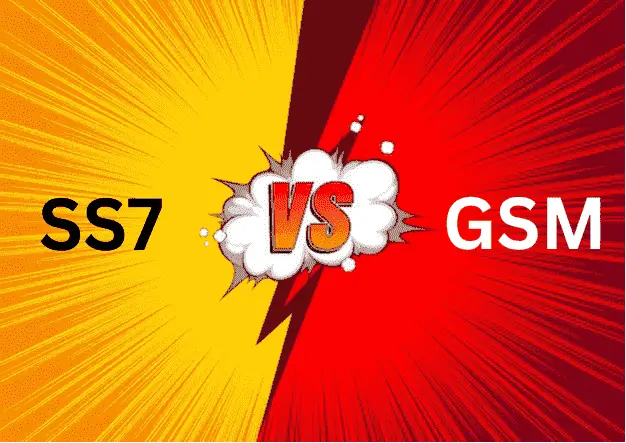The telecommunications industry has witnessed significant advancements over the years, leading to the emergence of various technologies that have revolutionized the way we communicate. Two crucial components in this landscape are Signaling System 7 (SS7) and Global System for Mobile Communications (GSM).
In this article, we will see the key differences of SS7 vs GSM, exploring their functionalities, architectures, and the impact they have on telecommunication networks.
Understanding SS7
Signaling System 7 (SS7) is a set of protocols designed for controlling and managing the signaling network of telecommunication systems. Its primary purpose is to establish and manage calls, handle signaling messages, and facilitate information exchange between network elements. SS7 operates on a separate signaling network, running parallel to the GSM network, and is responsible for various critical functions such as call setup, call routing, and service provisioning.
SS7 plays a vital role in enabling advanced telecommunication services such as intelligent network features, prepaid billing systems, and location-based services. It provides the backbone for communication between different service providers, allowing seamless interconnection and global reachability.
Exploring GSM
The Global System for Mobile Communications (GSM) is a widely adopted standard for digital cellular communication. GSM encompasses a complete cellular network architecture that enables voice and data services over mobile devices. It employs Time Division Multiple Access (TDMA) technology to divide the available frequency spectrum into time slots, allowing multiple users to share the same frequency band simultaneously.
GSM offers numerous advantages, including high-quality voice calls, efficient spectrum utilization, and seamless roaming capabilities. It revolutionized the mobile industry by introducing the concept of SIM (Subscriber Identity Module) cards, enabling users to switch devices while retaining their personal information and network access.
SS7 vs GSM
While SS7 and GSM are interconnected, they serve distinct purposes within the telecommunications landscape. The following are the key differences between SS7 and GSM:
- Functionality: SS7 operates as a separate signaling network that handles call setup, routing, and service provisioning, whereas GSM represents the entire cellular network architecture that enables voice and data services.
- Focus: SS7 primarily focuses on the signaling aspect of telecommunications, facilitating communication between different network elements, while GSM focuses on providing end-to-end mobile communication services.
- Network Structure: SS7 operates on a separate network, running parallel to the GSM network, and is dedicated to handling signaling messages. On the other hand, GSM includes base stations, mobile switching centers, and other network elements to enable voice and data transmission.
- Protocol Stack: SS7 utilizes the SS7 protocol stack, which consists of several layers such as the Message Transfer Part (MTP), Signaling Connection Control Part (SCCP), and Transaction Capabilities Application Part (TCAP). GSM, on the other hand, employs the GSM protocol stack, comprising the Radio Interface Layer, Base Station System, Network Switching Subsystem, and Operation and Support Subsystem.
- Services Provided: SS7 enables advanced telecommunication services such as intelligent network features, prepaid billing systems, and location-based services. In contrast, GSM offers voice calls, text messaging (SMS), multimedia messaging (MMS), and data services like internet connectivity.
- Security: Both SS7 and GSM have faced security vulnerabilities in the past. SS7, being a signaling protocol, has been susceptible to certain attacks, allowing unauthorized access to subscriber information or call interception. GSM has also experienced security breaches, including the encryption algorithms used in the early versions. However, both technologies have evolved, implementing stronger security measures to address these concerns.
- Integration: SS7 and GSM are integrated to ensure smooth communication within mobile networks. SS7 protocols are utilized for various functions, including authentication, roaming, and call setup, within the GSM infrastructure. This integration enables interoperability between different telecommunication networks.
- Evolving Standards: Both SS7 and GSM have evolved over time. SS7 has seen advancements, including the introduction of SIGTRAN (SS7 over IP), which enables the transport of SS7 messages over IP networks. Similarly, GSM has progressed from 2G to 3G, 4G, and now 5G, incorporating faster data speeds, enhanced voice quality, and additional features.
Conclusion
SS7 and GSM are integral components of the telecommunications ecosystem, each serving a distinct purpose. While SS7 focuses on the signaling aspect, enabling advanced services and interconnectivity between networks, GSM provides end-to-end mobile communication services over a cellular network architecture.
Understanding the differences between these technologies allows us to appreciate the intricate workings of the telecommunication systems we rely on daily. With ongoing advancements in telecommunication, both SS7 and GSM continue to play vital roles in shaping the future of communication and connectivity.
